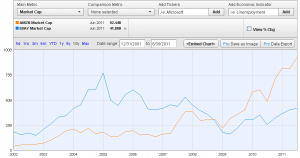I worked a long time in a financial company (one of Fortune 200) in the US. It’s quite a complex process to start a project, or you can say, make some changes or create something new. Once I had an idea of a new project which I was very excited about, and I pitched it to our team’s VP at a gathering, he was very excited about it as well. However, to my surprise, his first question was: “does your project have a customer?” Since I clearly did not, he explained: “every project has to have a customer”. That’s quite an interesting learning experience. It turns out that in addition to customer, there are a number of other roles in a typical project in an enterprise, the table below lists out their roles and responsibilities.
| Role | Expectations |
| Program Sponsor | •Influence strategic direction •Serve as tie breaker for major decisions |
| Steering Committee | •Set strategic direction•Approve major decisions
•Review progress of program •Provide guidance and feedback on plans |
| Program Customer | •Set conditions of satisfaction•Approve decisions not requiring executive review
•Review progress of program •Provide guidance and feedback on plans |
| Program Manager | •Ensure program governance (Project Management SME)•Program status updates
•Impact Assessment/Process Navigation |
| Leads | •Provide LOB requirements & timelines•Provide resources for Core Team activities
•Resolve cross-functional and cross-organizational issues • |
| Informed Stakeholders | •Review & provide feedback on program scope and delivery plan |
